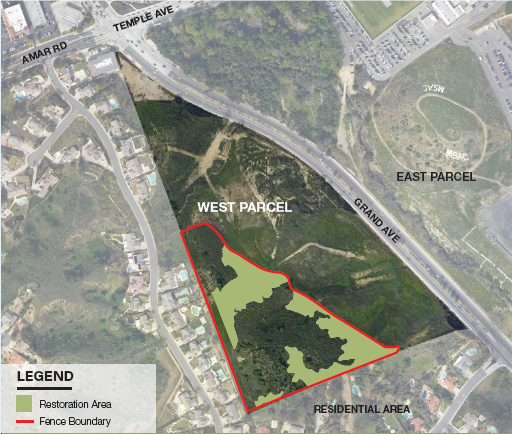West Parcel Restoration Planned

October 28, 2021 - 04:00 PM
Continuing its long-standing commitment to protecting Mt. SAC’s natural resources, the college is getting ready to launch a six-month habitat restoration project of its West Parcel in early 2022.
The college plans to preserve and expand existing coastal sage scrub habitat within an eight-acre portion of the 27-acre triangular site, located at the corner of Grand Avenue and Temple Avenue/Amar Road. The project includes removing non-native and invasive plant species, such as Short-pod Mustard, and then incorporating new plant installations to expand the native California coastal sage scrub species that already exist in the area. Some of the species that will be planted include Black Sage, California Buckwheat, California Sagebrush, Golden Yarrow, and Toyon.
Once planting is complete, biologists will monitor the restoration site for a five-year period to track establishment of the plants and wildlife use of the area. During this five-year period, the site will be regularly maintained to control establishment of non-native species and to remove trash from the restoration site. After the five-year maintenance and monitoring program is complete, Mt. SAC will continue to monitor and maintain the site in perpetuity to ensure long-term success of the restored habitat.
Reclaimed water will temporarily irrigate the new plantings in order to relieve stress on freshwater supplies. The residual undeveloped area of West Parcel will return to its original use as cattle grazing pastureland – an activity that will control brush overgrowth and help support the college’s Animal Sciences instructional programs.
The West Parcel habitat restoration is one of three projects dedicated to preserving the campus’ natural environment. The college in 2019 finished the restoration and expansion of Mt. SAC’s 56-year-old Wildlife Sanctuary and Snow Creek, and in July 2020 completed the installation of 200 California Black Walnut plantings on the north face of Reservoir Hill. These were planted to replace trees that were removed to allow for the construction of the new Champion Parking Structure and future gymnasium.
“I am proud that the college not only expanded the sanctuary but has also made it a priority and used it for mitigation of some of the work being done on campus,” said Biology professor Mark Cooper. “One of the classes I teach is ‘Humans and the Environment’ and the value of showing what can be done to restore an area and bring back local species cannot be measured. It is one thing to talk about sustainability and restoration. It is another to actual show it as a work in progress and what an institution can do when they set their mind to it.”
The restoration of Mt. SAC Hill and the West Parcel with coastal sage scrub is a great start in creating habitat for the endangered California Gnatcatcher, Cooper added. “It also provides a corridor, linking with other areas, that allows species to migrate through. Since the restorations, I am seeing species return that I haven’t seen on the hill for years, like the Cactus Wren and California Quail.”
The restoration of the habitat within the Wildlife Sanctuary and the coastal sage scrub habitat also provides professors with an opportunity to show the students the benefits of habitat restoration, said Biology professor Tyler Flisik.
“We use the restored habitats to teach the students about our native plant species and their adaptations for survival in our hot, dry climate, as well as the ecology of our native animals that depend on these habitats,” said Flisik, who with Cooper will take over the oversight of the restored habitats once the restorations are complete. “We also use the restored habitats to compare the ecological benefits of an area with a diversity of native plant species to an area covered with non-native, invasive species like mustard or castor bean.”
Flisik said he also uses the restored habitat to discuss the importance of habitat mitigation, and how it has led to the expansion of critical habitat for endangered species like the California Gnatcatcher. “It is always a unique experience for our students when we get a chance to see the California Gnatcatchers in the sanctuary and I can inform the students that it is an endangered species that depends on coastal sage scrub habitat for its survival,” he said.
Like Cooper, Flisik says he is proud of Mt. SAC's commitment to habitat restoration and the preservation of outdoor learning environments for students. “Mt. SAC has provided our students with an incredible opportunity to study nature on campus, while also seeing the benefits of habitat restoration within their own community,” Flisik said. “I am thrilled to be a part of it.”

